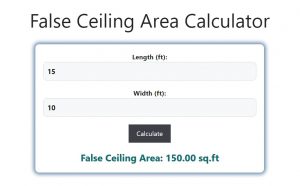About False Ceiling Area Calculator (Formula)
A false ceiling, also known as a drop ceiling or suspended ceiling, is an architectural feature that can enhance the aesthetics and functionality of a room. It not only provides an opportunity for decorative designs but also helps with insulation and soundproofing. To accurately estimate the materials needed for a false ceiling installation, calculating the area is essential. This is where the False Ceiling Area Calculator comes into play, allowing users to determine the area quickly and efficiently.
Formula
The formula for calculating the area of a false ceiling is: False Ceiling Area = Length × Width. In this formula:
- Length is the longer side of the ceiling.
- Width is the shorter side of the ceiling.
- The resulting area is typically measured in square feet or square meters.
How to Use
Using the False Ceiling Area Calculator is straightforward:
- Measure the Room: Use a tape measure to determine the length and width of the room where the false ceiling will be installed.
- Input the Measurements: Enter the length and width into the calculator.
- Calculate: Click the “Calculate” button to obtain the area of the false ceiling.
- Review the Results: Analyze the output to understand how much material will be needed for the installation.
Example
Suppose you have a room with the following dimensions:
- Length: 15 feet
- Width: 10 feet
To calculate the area of the false ceiling:
False Ceiling Area = Length × Width
False Ceiling Area = 15 ft × 10 ft
False Ceiling Area = 150 square feet
In this example, you would need enough materials to cover 150 square feet of false ceiling.

FAQs
- What is a false ceiling?
A false ceiling is a secondary ceiling hung below the main ceiling, used for aesthetic and functional purposes. - Why would I install a false ceiling?
False ceilings can improve aesthetics, reduce noise, hide ductwork, and provide better insulation. - How do I measure the length and width of a room?
Use a tape measure to find the distance from one wall to the opposite wall for both dimensions. - Can I use the calculator for irregularly shaped rooms?
For irregular shapes, divide the area into smaller rectangles or squares, calculate each area, and then sum them. - What materials are typically used for false ceilings?
Common materials include gypsum board, plaster, and acoustic tiles. - How do I calculate the area if the ceiling has fixtures?
Subtract the area of any fixtures from the total area calculated. - Do false ceilings affect room height?
Yes, installing a false ceiling can lower the effective height of a room. - Is a false ceiling suitable for all rooms?
False ceilings are common in living rooms, offices, and commercial spaces, but may not be necessary in every room. - How can I improve lighting with a false ceiling?
False ceilings can incorporate recessed lighting or LED strips for enhanced ambiance. - Can I install a false ceiling myself?
While it’s possible, hiring a professional is advisable for the best results and safety. - What is the average cost of installing a false ceiling?
Costs vary widely depending on materials and labor but typically range from $3 to $10 per square foot. - How long does it take to install a false ceiling?
Installation time can vary from a few hours to a few days based on the project’s complexity. - Are false ceilings easy to maintain?
Yes, they require minimal maintenance; occasional cleaning is usually sufficient. - Will a false ceiling reduce heating and cooling costs?
Yes, by providing insulation, false ceilings can improve energy efficiency. - What are the design options for false ceilings?
False ceilings can be flat, sloped, or curved and can include various textures and colors. - Can I install a false ceiling in a bathroom?
Yes, but moisture-resistant materials should be used to prevent damage. - How can I add ventilation to a false ceiling?
Ensure proper design to allow for air circulation, using vent covers or grills. - Is it possible to integrate soundproofing into a false ceiling?
Yes, using specific soundproofing materials can enhance acoustics. - What are the safety considerations for false ceilings?
Ensure proper installation and materials are used to prevent fire hazards and structural issues. - Can I paint my false ceiling?
Yes, false ceilings can be painted to match your interior decor, but use appropriate paint types for best results.
Conclusion
The False Ceiling Area Calculator is a valuable tool for anyone looking to install a false ceiling in their home or commercial space. By understanding how to calculate the area and the benefits of false ceilings, you can make informed decisions that enhance your interior design while improving functionality. Whether you’re planning a DIY project or hiring professionals, this calculator simplifies the process, ensuring you have the right amount of materials for a successful installation.